
-
 Afrikaans
Afrikaans -
 Albanian
Albanian -
 Amharic
Amharic -
 Arabic
Arabic -
 Armenian
Armenian -
 Azerbaijani
Azerbaijani -
 Basque
Basque -
 Belarusian
Belarusian -
 Bengali
Bengali -
 Bosnian
Bosnian -
 Bulgarian
Bulgarian -
 Catalan
Catalan -
 Cebuano
Cebuano -
 Corsican
Corsican -
 Croatian
Croatian -
 Czech
Czech -
 Danish
Danish -
 Dutch
Dutch -
 English
English -
 Esperanto
Esperanto -
 Estonian
Estonian -
 Finnish
Finnish -
 French
French -
 Frisian
Frisian -
 Galician
Galician -
 Georgian
Georgian -
 German
German -
 Greek
Greek -
 Gujarati
Gujarati -
 Haitian Creole
Haitian Creole -
 hausa
hausa -
 hawaiian
hawaiian -
 Hebrew
Hebrew -
 Hindi
Hindi -
 Miao
Miao -
 Hungarian
Hungarian -
 Icelandic
Icelandic -
 igbo
igbo -
 Indonesian
Indonesian -
 irish
irish -
 Italian
Italian -
 Japanese
Japanese -
 Javanese
Javanese -
 Kannada
Kannada -
 kazakh
kazakh -
 Khmer
Khmer -
 Rwandese
Rwandese -
 Korean
Korean -
 Kurdish
Kurdish -
 Kyrgyz
Kyrgyz -
 Lao
Lao -
 Latin
Latin -
 Latvian
Latvian -
 Lithuanian
Lithuanian -
 Luxembourgish
Luxembourgish -
 Macedonian
Macedonian -
 Malgashi
Malgashi -
 Malay
Malay -
 Malayalam
Malayalam -
 Maltese
Maltese -
 Maori
Maori -
 Marathi
Marathi -
 Mongolian
Mongolian -
 Myanmar
Myanmar -
 Nepali
Nepali -
 Norwegian
Norwegian -
 Norwegian
Norwegian -
 Occitan
Occitan -
 Pashto
Pashto -
 Persian
Persian -
 Polish
Polish -
 Portuguese
Portuguese -
 Punjabi
Punjabi -
 Romanian
Romanian -
 Russian
Russian -
 Samoan
Samoan -
 Scottish Gaelic
Scottish Gaelic -
 Serbian
Serbian -
 Sesotho
Sesotho -
 Shona
Shona -
 Sindhi
Sindhi -
 Sinhala
Sinhala -
 Slovak
Slovak -
 Slovenian
Slovenian -
 Somali
Somali -
 Spanish
Spanish -
 Sundanese
Sundanese -
 Swahili
Swahili -
 Swedish
Swedish -
 Tagalog
Tagalog -
 Tajik
Tajik -
 Tamil
Tamil -
 Tatar
Tatar -
 Telugu
Telugu -
 Thai
Thai -
 Turkish
Turkish -
 Turkmen
Turkmen -
 Ukrainian
Ukrainian -
 Urdu
Urdu -
 Uighur
Uighur -
 Uzbek
Uzbek -
 Vietnamese
Vietnamese -
 Welsh
Welsh -
 Bantu
Bantu -
 Yiddish
Yiddish -
 Yoruba
Yoruba -
 Zulu
Zulu


Aug . 07, 2024 15:35 Back to list
Exploring the Mechanisms and Applications of Chain Pulley Systems in Crane Operations
Understanding Chain Pulley Cranes An Overview
Chain pulley cranes are essential tools used in various industries for lifting and moving heavy loads efficiently and safely. They come in numerous designs and configurations, each tailored to meet specific lifting needs. At the core of the functionality of a chain pulley crane is the principles of mechanics and leverage, which significantly reduce the effort required to raise heavy items.
What is a Chain Pulley Crane?
A chain pulley crane, often referred to as a block and tackle, consists of a system of pulleys and a chain that work together to lift an object. The basic setup includes a fixed block (a combination of pulleys) and a movable block connected via a chain. When the chain is pulled, the arrangement of pulleys multiplies the force exerted by the user, allowing a person to lift an object that would otherwise be too heavy to manage.
How It Works
The mechanical advantage provided by the pulley system is one of the key features of a chain pulley crane. By using multiple pulleys, the weight is distributed, and the amount of force required to lift the load is significantly reduced. For instance, with a simple pulley system that consists of two pulleys, the effort needed to lift the load is halved. This means that for a load weighing 200 kilograms, a person only needs to exert 100 kilograms of force to raise it.
The chain mechanism is particularly important in this system because it ensures that the load is lifted steadily and distributes the weight evenly. Chains are less prone to stretching compared to ropes, which makes them ideal for heavy-duty applications. Furthermore, chains provide better grip and traction, reducing the risk of slippage during operation.
Applications of Chain Pulley Cranes
Chain pulley cranes are versatile and used in various applications ranging from construction and manufacturing to warehousing and shipping. In construction sites, for example, they are frequently used to lift materials such as steel beams, heavy machinery, and concrete blocks. In warehouses, they help in moving pallets and other heavy items, improving efficiency in inventory management.
chain pulley crane

Additionally, chain pulley cranes are commonly found in shipyards, where they assist in hoisting heavy loads onto ships or removing them from vessels. The automotive industry also benefits from these cranes for lifting car parts during assembly or repair.
Advantages of Chain Pulley Cranes
1. Efficiency By leveraging mechanical advantage, chain pulley cranes allow workers to lift heavy loads with less physical strain, increasing productivity.
2. Safety These systems mitigate the risk of injury associated with lifting heavy objects by minimizing the physical effort required from the operator.
3. Durability Chain pulley cranes are built to withstand extreme weights and tough working conditions. Their robust construction ensures longevity and reliability over time.
4. Cost-effectiveness Investing in a chain pulley crane can reduce labor costs by enabling fewer workers to accomplish tasks that would typically require a larger team.
Conclusion
In summary, chain pulley cranes are invaluable tools in various industries, providing an efficient, safe, and durable solution for lifting heavy loads. Their simple yet effective design maximizes mechanical advantage, facilitating tasks across construction, manufacturing, warehousing, and more. As industries continue to evolve, the demand for such effective lifting solutions will persist, making chain pulley cranes a staple in modern operations. Understanding their mechanics and applications can help businesses optimize their processes and enhance productivity in their respective fields.











